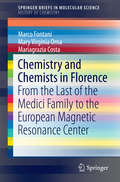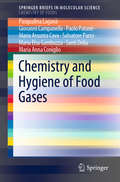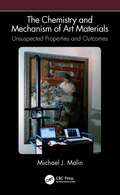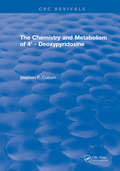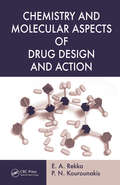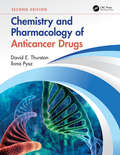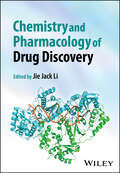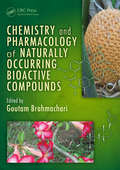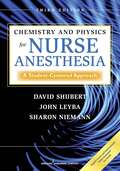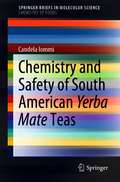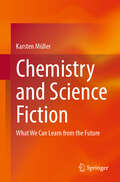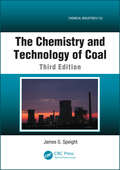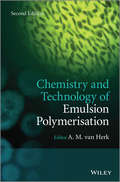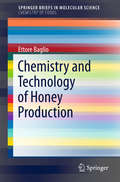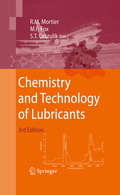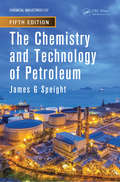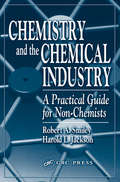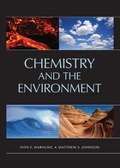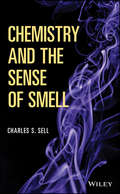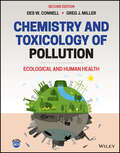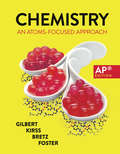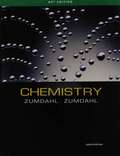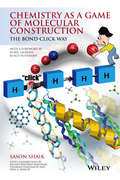- Table View
- List View
Chemistry And Chemical Reactivity (AP Edition) (Eighth Edition)
by John C. Kotz Paul M. Treichel John R. TownsendSucceed in chemistry with the clear explanations, problem-solving strategies, and dynamic study tools of CHEMISTRY & CHEMICAL REACTIVITY, 8e. Combining thorough instruction with the powerful multimedia tools you need to develop a deeper understanding of general chemistry concepts, the text emphasizes the visual nature of chemistry, illustrating the close interrelationship of the macroscopic, symbolic, and particulate levels of chemistry. The art program illustrates each of these levels in engaging detail--and is fully integrated with key media components. In addition access to OWL may be purchased separately or at a special price if packaged with this text. OWL is an online homework and tutorial system that helps you maximize your study time and improve your success in the course. OWL includes an interactive eBook, as well as hundreds of guided simulations, animations, and video clips.
Chemistry and Chemists in Florence: From the Last of the Medici Family to the European Magnetic Resonance Center (SpringerBriefs in Molecular Science)
by Marco Fontani Mary Virginia Orna Mariagrazia CostaThis brief offers a novel vision of the city of Florence, tracing the development of chemistry via the biographies of its most illustrious chemists. It documents not only important scientific research that came from the hands of Galileo Galilei and the physicists who followed in his footsteps, but also the growth of new disciplines such as chemistry, pharmaceutical chemistry, and biochemistry. It recounts how, in the Middle Ages, chemistry began as an applied science that served to bolster the Florentine economy, particularly in the textile dyeing industry. Later, important scientific collections founded by the ruling Medici family served as the basis of renowned museums that now house priceless artifacts and instruments. Also described in this text are the chemists such as Hugo Schiff, Angelo Angeli, and Luigi Rolla, who were active over the course of the following century and a quarter. The authors tell the story of the evolution of the Royal University of Florence, which ultimately became the University of Florence. Of interest to historians and chemists, this tale is told through the lives and work of the principal actors in the university's department of chemistry.
Chemistry and Hygiene of Food Gases (SpringerBriefs in Molecular Science)
by Salvatore Parisi Pasqualina Laganà Paolo Patanè Santi Delia Maria Anna Coniglio Giovanni Campanella Maria Assunta Cava Maria Elsa GambuzzaThis book focuses on the use of food gases in the food industry, their different applications and their role in food processing, packaging and transportation. Since these gases come into contact with food, they must comply with strict of labeling, purity and hygiene standards in order to ensure food safety.The book discusses various implications of food gases in the food chain, providing examples of how they can be used to limit food waste and losses. The first two chapters examine the classification and role of food gases in Europe, and the third chapter then explores the chemical and physical features of commonly used food gases in the food and food packing industries. The fourth chapter highlights the impact of food gases on human health due to their possible abuse and misuse. This book appeals to researchers and professionals working in food production and quality control.
The Chemistry and Mechanism of Art Materials: Unsuspected Properties and Outcomes
by Michael J. MalinThis unique book presents an integrated approach to the chemistry of art materials, exploring the many chemical processes involved. The Chemistry and Mechanism of Art Materials: Unsuspected Properties and Outcomes engages readers with historical vignettes detailing examples of unexpected outcomes due to materials used by known artists. The book discusses artists’ materials focusing on relevant chemical mechanisms which underlie the synthesis and deterioration of inorganic pigments in paintings, the ageing of the binder in oil paintings, and sulfation of wall paintings as well as the toxicology of these pigments and solvents used by artists. Mechanisms illustrate the stepwise structural transformation of a variety of art materials. Based on the author’s years of experience teaching college chemistry, the approach is descriptive and non-mathematical throughout. An introductory section includes a review of basic concepts and provides concise descriptions of analytical methods used in contemporary art conservation. Additional features include: Illustrations of chemical reactivity associated with art materials Includes a review of chemical bonding principles, redox and mechanism writing Covers analytical techniques used by art conservation scientists Accessible for readers with a limited science background Provides numerous references for readers seeking additional information
The Chemistry and Metabolism of 4' - Deoxypyridoxine
by Stephen P. CoburnThis review organizes the existing literature on deoxypyridoxine in order to provide additional insights for developing further work. By providing a thorough analysis of previous work with deoxypyridoxine, it can be used more effectively as a tool for examining various metabolic pathways and explored further for its potential clinical use in cancer therapy, immunosuppression, or other areas. The book also stimulate some new insights into action of vitamin B6 itself.
Chemistry and Molecular Aspects of Drug Design and Action
by E. A. Rekka P. N. KourounakisAn ever-increasing demand for better drugs, elevated safety standards, and economic considerations have all led to a dramatic paradigm shift in the way that drugs are being discovered and developed. Known as rational drug design, this contemporary process is defined by three main steps: the discovery of lead compounds, surgical manipulation to deve
Chemistry and Pharmacology of Anticancer Drugs
by David E. Thurston Ilona PyszWhile drug therapies developed in the last 80 years have markedly improved treatment outcomes and the management of some types of cancers, the lack of effectiveness and side effects associated with the most common treatment types remain unacceptable. However, recent technological advances are leading to improved therapies based on targeting distinct biological pathways in cancer cells. Chemistry and Pharmacology of Anticancer Drugs is a comprehensive survey of all families of anticancer agents and therapeutic approaches currently in use or in advanced stages of clinical trials, including biological-based therapies. The book is unique in providing molecular structures for all anticancer agents, discussing them in terms of history of development, chemistry, mechanism of action, structure–function relationships, and pharmacology. It also provides relevant information on side effects, dosing, and formulation. The authors, renowned scientists in cancer research and drug discovery, also provide up-to-date information on the drug discovery process, including discussions of new research tools, tumor-targeting strategies, and fundamental concepts in the relatively new areas of precision medicine and chemoprevention. Chemistry and Pharmacology of Anticancer Drugs is an indispensable resource for cancer researchers, medicinal chemists and other biomedical scientists involved in the development of new anticancer therapies. Its breadth of coverage, clear explanations, and illustrations also make it suitable for undergraduate and postgraduate courses in medicine, pharmacy, nursing, dentistry, nutrition, the biomedical sciences, and related disciplines. Key Features: Summarizes the fundamental causes of cancer, modes of treatment, and strategies for cancer drug discovery Brings together a broad spectrum of information relating to the chemistry and pharmacology of all families of anticancer agents and therapies Includes up-to-date information on cutting-edge aspects of cancer treatments such as biomarkers, pharmacogenetics, and pharmacogenomics Features new chapters on the "Evolution of Anticancer Therapies", "Antibody-Based Therapies", and "Cancer Chemoprevention"
Chemistry and Pharmacology of Drug Discovery
by Jie Jack LiCase studies of 20 successful FDA-approved drugs, from biological rationale to clinical efficacy studies and state-of-the-art applications Chemistry and Pharmacology of Drug Discovery illustrates how chemistry, biology, pharmacokinetics, and a host of disciplines come together to produce successful medicines, discussing a total of 20 drugs that are all FDA-approved post 2021—some of which are first-in-class and revolutionary. The four sections in this book cover Infectious Disease, Cancer Drugs, CNS Drugs, and Miscellaneous Drugs. Each chapter covers background material on the drug class and/or disease indication and key aspects relevant to the discovery of the drug, including structure-activity relationships, pharmacokinetics, drug metabolism, efficacy, and safety. This book is contributed to by various veterans and well-known experts in medical chemistry, many of whom discovered the drugs they reviewed, leading to tremendous quality and depth of insight. Some of the drugs covered in Chemistry and Pharmacology of Drug Discovery include: Nirmatrelvir (Paxlovid with Ritonavir), a 3-chymotrypsin-like protease inhibitor for treating SARS-CoV-2 infectionDoravirine (Pifeltro), a third-generation non-nucleoside reverse transcriptase inhibitor for the treatment of HIV-1 infectionOteseconazole (Vivjoa), a CYP51 inhibitor for treating recurrent vulvovaginal candidiasis, and Rimegepant (Nurtec ODT), a CGRP antagonist for treating migraineCiprofol (Cipepofol), a γ-Aminobutyric acid receptor agonist for induction of anesthesia, and Ozanimod (Zeposia), an S1P receptor antagonist for treating multiple sclerosisDeucravacitinib (Sotyktu), a first-in-class deuterated TYK2 inhibitor for the treatment of plaque psoriasis Chemistry and Pharmacology of Drug Discovery serves as an excellent and highly authoritative learning resource for medicinal, organic, synthetic, and process chemists as well as research scientists in lead optimization and process development.
Chemistry and Pharmacology of Naturally Occurring Bioactive Compounds
by Bruce A. MoyerNatural products play crucial roles in modern drug development, and constitute a prolific source of novel lead compounds or pharmacophores for ongoing drug discovery programs. Chemistry and Pharmacology of Naturally Occurring Bioactive Compounds presents cutting-edge research in the chemistry of bioactive natural products and demonstrates how natur
Chemistry and Physics for Nurse Anesthesia: A Student-Centered Approach
by David Shubert John Leyba Sharon NiemannWith a focus on chemistry and physics content that is directly relevant to the practice of anesthesia, this text--written in an engaging, conversational style--supplies all the scientific information required for the combined chemistry and physics course for nurse anesthesia students. Now in its third edition, the text is updated and reorganized to facilitate a greater ease and depth of understanding. The addition of a third author--a practicing nurse anesthetist--enhances the clinical relevance of the scientific information. Clinical scenarios now begin every chapter, and a concluding chapter, new to this edition, provides detailed, step-by-step solutions to the book's review questions. Also included is a comprehensive list of need-to-know equations. <P><P>The third edition retains the many outstanding learning features from earlier editions, including a special focus on gases, the use of illustrations to demonstrate how scientific concepts relate directly to their clinical application in anesthesia, and end-of-chapter summaries and review questions to facilitate self-assessment. Fifteen online videos enhance teaching and learning, and abundant clinical application scenarios help reinforce scientific principles and relate them to day-to-day anesthesia procedures. This clear, easy-to-read text will help even the most chemistry- and physics-phobic students to master the foundations of these sciences and competently apply them in a variety of clinical situations.
Chemistry and Safety of South American Yerba Mate Teas (SpringerBriefs in Molecular Science)
by Candela IommiThis book explores the traditional use of Ilex paraguariensis, a plant that is widely distributed in South America. Thanks to its purported properties, it has been used for centuries in the form of teas with a variety of names, including: ‘yerba mate’ (Argentina), ‘chimarrão’ (Brazil), and others. Ilex paraguariensis and its teas (also referred to as ‘mate teas’) are well known because of their alleged pharmacological effects in numerous common conditions, including obesity, osteoporosis, constipation, arthritis, and hypertension. These effects are generally ascribed to yerba mate teas because the botanical species contains bioactive and stimulating substances like caffeine (originally dubbed ‘mateine’), various alkaloids, and several phenolic acids. Interestingly, the chemical profiles of these teas can fluctuate over time, creating serious production problems. As a result, it is difficult to reliably determine their safety and health effects on humans. In response to the global interest in these products, this book offers a reference guide to ‘yerba mate’/‘chimarrão’ teas. It analyzes their chemical profiles, discusses their bioactive features, and addresses their safety and health effects. In addition, since the cultural heritage of yerba mate has greatly contributed to its international success, the book also provides information on its historical legacy, regulatory aspects, and the global market.
Chemistry and Science Fiction: What We Can Learn from the Future
by Karsten MüllerThis book aims to introduce students (and other interested laypeople) to chemistry in a fun way, using examples from science fiction. The individual chapters are deliberately kept short to enhance readability. The book can especially be used as supplementary reading for lectures in chemistry and related disciplines.
The Chemistry and Technology of Coal (Chemical Industries)
by James G. SpeightThe demand for coal use (for electricity generation) and coal products, particularly liquid fuels and chemical feedstocks, is increasing throughout the world. Traditional markets such as North America and Europe are experiencing a steady increase in demand whereas emerging Asian markets, such as India and China, are witnessing a rapid surge in dema
Chemistry and Technology of Emulsion Polymerisation
by A. M. van HerkChemistry and Technology of Emulsion Polymerisation 2e provides a practical and intuitive explanation of emulsion polymerization, in combination with both conventional and controlled radical polymerization. For those working in industry, coupling theory with everyday practice can be difficult. By carefully explaining the principles of the reaction, based on well-designed experimental investigation, the book explains how the principles relate to practical application.The second edition of this book includes a new chapter on morphology of latex particles, a rapidly progressing area where modelling the thermodynamic and kinetic aspects of phase separation and morphology has developed into a mature and powerful tool to predict and control morphology of latex particles. Another area that is rapidly progressing is the application of controlled radical polymerisation in emulsion polymerization. Controlled radical polymerisation is used in aiding encapsulation of inorganic particles like pigment particles and clay platelets. These latest developments are included in the second edition.
Chemistry and Technology of Honey Production (SpringerBriefs in Molecular Science)
by Ettore BaglioThis Brief explains and discusses honey and its production from a chemical perspective. It outlines why honey is a special and unique food, being produced by bees from the nectar of plants or from secretions of living parts of plants. Although glucose and fructose are the main constituents of honey, its overall composition is far from being simple or uniform: other substances such as organic acids, enzymes, or minerals are found in varying amounts. In this Brief, the author addresses the factors that influence the composition of the honey as well as the consequences that the composition has on properties such as color, crystallization, density, viscosity, or the refractive index. This Brief also introduces some of the most commonly used quality parameters for the determination of ageing and/or overheating: 5-hydroxymethylfurfural (HMF) and diastase. Other recently proposed constituents for quality parameters are also mentioned, e. g. 1,2 dicarbonyl compounds (3 deoxyglucosone, methylglyoxal, glyoxal) and furosine, also named 2-furoylmethyl lysine.
Chemistry and Technology of Lubricants
by Malcolm F. Fox Stefan T. Orszulik Roy M. Mortier"Chemistry and Technology of Lubricants" describes the chemistry and technology of base oils, additives and applications of liquid lubricants. This Third Edition reflects how the chemistry and technology of lubricants has developed since the First Edition was published in 1992. The acceleration of performance development in the past 35 years has been as significant as in the previous century: Refinery processes have become more precise in defining the physical and chemical properties of higher quality mineral base oils. New and existing additives have improved performance through enhanced understanding of their action. Specification and testing of lubricants has become more focused and rigorous. "Chemistry and Technology of Lubricants" is directed principally at those working in the lubricants industry as well as individuals working within academia seeking a chemist's viewpoint of lubrication. It is also of value to engineers and technologists requiring a more fundamental understanding of the subject.
The Chemistry and Technology of Petroleum (ISSN)
by James G. SpeightWith demand for petroleum products increasing worldwide, there is a tendency for existing refineries to seek new approaches to optimize efficiency and throughput. In addition, changes in product specifications due to environmental regulations greatly influence the development of petroleum refining technologies. These factors underlie the need for t
Chemistry and the Chemical Industry: A Practical Guide for Non-Chemists
by Robert A. Smiley Harold L. JacksonAs chemical companies strive to be more competitive in the world economy, it is essential that their employees, including sales and marketing personnel, as well as administrative support groups understand the basic concepts of the science upon which the industry is based. The authors, who have over 100 years of combined experience in the chemical i
Chemistry and the Environment
by Sven E. Harnung Matthew S. JohnsonThis textbook presents the chemistry of the environment using the full strength of physical, inorganic, and organic chemistry, in addition to the necessary mathematics and physics. It provides a broad yet thorough description of the environment and the environmental impact of human activity using scientific principles. It gives an accessible account while paying attention to the fundamental basis of the science, showing derivations of formulas and giving primary references and historical insight. The authors make consistent use of professionally accepted nomenclature (IUPAC and SI), allowing transparent access to the material by students and scientists from other fields. This textbook has been developed through many years of feedback from students and colleagues. It includes more than 400 online student exercises that have been class tested and refined. The book will be invaluable in environmental chemistry courses for advanced undergraduate and graduate students and professionals in chemistry and allied fields.
Chemistry and the Sense of Smell
by Charles S. Sell“I cannot recommend this fascinating book highly enough.” –Simon Cotton, Chemistry & Industry, September 2014 “In conclusion: A comprehensive introduction to the world of odours, not only for chemists.” –review in German: Monika Paduch, Gefahrstoffe - Reinhaltung Luft, October 2014 A comprehensive overview of fragrance chemistry Fragrance materials are universal, from personal care products to household cleaners, laundry products, and more. Although many of the scents themselves are synthesized in a lab, the actual mechanism of odour has long baffled chemists who attempt to model it for research. In Chemistry and the Sense of Smell, industry chemist Charles S. Sell explores the chemistry and biology surrounding the human detection and processing of odour, providing a comprehensive, single-volume guide to the totality of fragrance chemistry. The correlation between molecular structure and odour is much more complex than initially thought, and the intricacies of the mechanism by which the brain interprets scent signals leaves much to be discovered. This book provides a solid foundation of fragrance chemistry and highlights the relationship between research and industry with topics such as: The analysis and characterization of odour The role scent plays in our lives The design and manufacture of new fragrance ingredients The relationship between molecular structure and odour The mechanism of olfaction Intellectual challenges and the future of the field Complete with illustrations that clarify difficult concepts and the structures of the molecules under discussion, Chemistry and the Sense of Smell is an all-inclusive guide to the science of scent. For professionals in the fragrance industry or related fields, this book is one resource that should not be overlooked.
Chemistry and Toxicology of Pollution: Ecological and Human Health
by Des W. Connell Gregory J. MillerDescribes the transport of pollutants through the environment and their impact on natural and human systems, fully updated to cover key topics in modern pollution science Chemistry and Toxicology of Pollution examines the interactions and adverse effects of pollution on both natural ecosystems and human health, addressing chemical, toxicological, and ecological factors at both the regional and global scale. The book is written using a conceptual framework that follows the interaction of a pollutant with the environment from distribution in the various abiotic sectors of the environment to exposure and effects on individuals and ecosystems. The authors also highlight the critical role of various socio-economic, political, and cultural aspects in achieving sustainable goals, strategies, and science-based solutions to pollution and health. This comprehensive volume covers the chemical behavior and governing principles of pollutants, their interactions with humans and ecosystems, and the methods and processes of environmental risk assessment and pollution management. Extensively revised and expanded, the second edition equips readers with the knowledge required to help lead the way towards a healthy and sustainable future. New chapters address current pollution issues such as global warming and climate change, recent advances in environmental science, the monitoring and evaluation of new and emerging pollutants, risk assessment and remediation, and innovative pollution management approaches and techniques. With in-depth material on human toxicology integrated throughout the text, Chemistry and Toxicology of Pollution: Provides an effective framework for interpreting the information produced by international, national, and local agencies Presents unifying theories and principles supported by up-to-date scientific literature Offers broad coverage of pollution science with an emphasis on North America, the UK, Europe, China, India, and Australia Discusses the similarities and differences of the impact of pollutants on the natural environment and humans Chemistry and Toxicology of Pollution, Second Edition enables readers to view pollution in its correct perspective and develop appropriate control measures. It is essential reading for scientists, academic researchers, policymakers, professionals working in industry, and advanced students in need of a clear understanding of the nature and effects of environmental pollution.
Chemistry (AP® Edition): An Atoms-focused Approach
by Thomas R. Gilbert Rein V. Kirss Stacey Lowery Bretz Natalie Foster Todd Abronowitz Kristen JonesThe first atoms-focused text and assessment package for the AP® course Fully aligned to the latest College Board’s curriculum framework, Chemistry: An Atoms-Focused Approach helps students understand chemistry at the micro, macro, and symbolic level. Author and chemistry education researcher, Stacey Lowery Bretz has incorporated her research on how students construct and interpret multiple representations into clear visualization pedagogy, which emphasizes the particulate nature of matter and helps students become expert problem solvers. This pedagogy extends beyond the book into the AP® teaching, learning, and assessment package. AP® is a trademark registered and/or owned by the College Board, which was not involved in the production of, and does not endorse, this product. This purchase offers access to the digital ebook only.
Chemistry, AP* Edition
by Steven S. Zumdahl Susan A. ZumdahlThis fully updated Ninth Edition of Steven and Susan Zumdahl's CHEMISTRY brings together the solid pedagogy, easy-to-use media, and interactive exercises that today's instructors need for their general chemistry course. Rather than focusing on rote memorization, CHEMISTRY uses a thoughtful approach built on problem-solving. For the Ninth Edition, the authors have added a new emphasis on critical systematic problem solving, new critical thinking questions, and new computer-based interactive examples to help students learn how to approach and solve chemical problems--to learn to think like chemists--so that they can apply the process of problem solving to all aspects of their lives. Students are provided with the tools to become critical thinkers: to ask questions, to apply rules and develop models, and to evaluate the outcome. In addition, Steven and Susan Zumdahl crafted ChemWork, an online program included in OWL Online Web Learning to support their approach, much as an instructor would offer support during office hours. ChemWork is just one of many study aids available with CHEMISTRY that supports the hallmarks of the textbook--a strong emphasis on models, real world applications, visual learning, and independent problem solving. Available with InfoTrac Student Collections http://gocengage. com/infotrac.
Chemistry, AP* Edition
by Steven S. Zumdahl Susan A. ZumdahlThis fully updated Ninth Edition of Steven and Susan Zumdahl's CHEMISTRY brings together the solid pedagogy, easy-to-use media, and interactive exercises that today's instructors need for their general chemistry course. Rather than focusing on rote memorization, CHEMISTRY uses a thoughtful approach built on problem-solving. For the Ninth Edition, the authors have added a new emphasis on critical systematic problem solving, new critical thinking questions, and new computer-based interactive examples to help students learn how to approach and solve chemical problems--to learn to think like chemists--so that they can apply the process of problem solving to all aspects of their lives. Students are provided with the tools to become critical thinkers: to ask questions, to apply rules and develop models, and to evaluate the outcome. In addition, Steven and Susan Zumdahl crafted ChemWork, an online program included in OWL Online Web Learning to support their approach, much as an instructor would offer support during office hours. ChemWork is just one of many study aids available with CHEMISTRY that supports the hallmarks of the textbook--a strong emphasis on models, real world applications, visual learning, and independent problem solving. Available with InfoTrac Student Collections http://gocengage. com/infotrac.
Chemistry as a Game of Molecular Construction
by Sason Shaik Racheli Ben-Knaz Wakshlak Roald Hoffmann Dina A. Sharon Usharani DandamudiThe proposed textbook takes the students into a fascinating journey that shows the universal aspect of chemistry: Chemistry is the window given to mankind to glimpse into his material-chemical essence and come to terms with its limitations. In the introductory chapter/lecture, the textbook discusses the connection between the "chemical matter" and love, sex, depression, addiction--all the properties we call "human". As we are made of chemical matter, this chapter makes a point why knowledge of chemistry is so essential to mankind. This preamble is followed by about 14 short chapters/lectures, which introduce chemistry as molecule building process, like a game of Lego.

